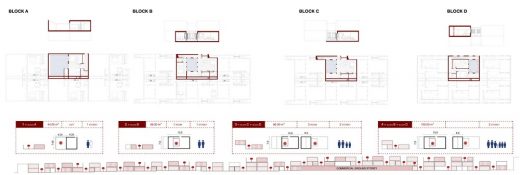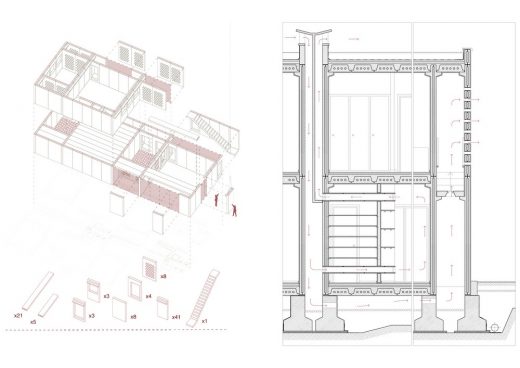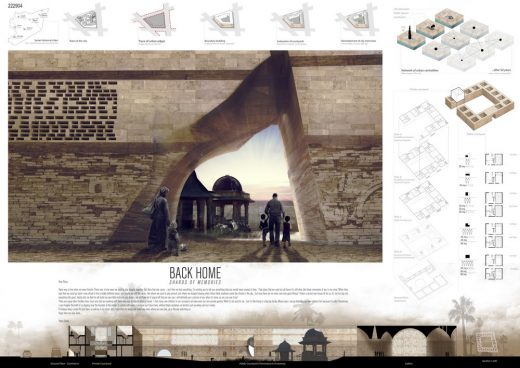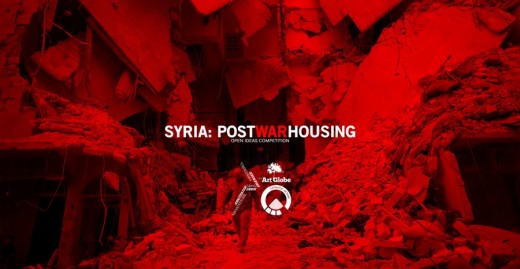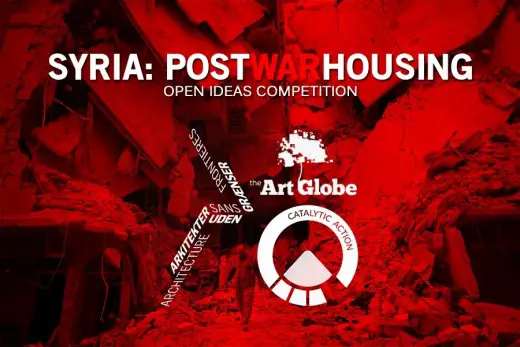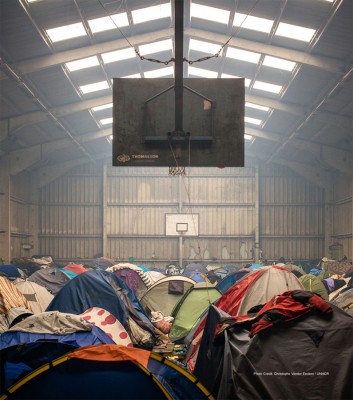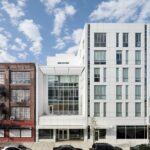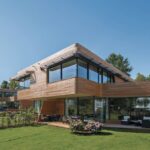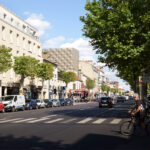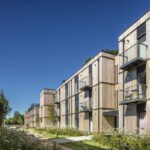Syria: Post-War Housing Competition Winner, Open Ideas Architecture Contest News
Syria: Post-War Housing Competition Winners News
New Architectural Contest in the Middle East by matterbetter: New Homes Design
20 Jul 2016
Syria: Post-War Housing Competition 2016 Winners
Syria: Post-War Housing Competition Winner
matterbetter design contest
matterbetter initiated ‘Syria: Post-War Housing Competition’ for architectural students and professionals.
Competition participants were asked to propose a solution for housing scarcity crisis, which will affect the country as more and more cities of the war-torn country will be freed and refugees will start to come back. Living conditions in the current refugee camps and temporary buildings across Europe and other countries are mostly inhuman, making refugees feel desperate, since there’s also nowhere to come back as the Syrian towns are in ruins, offering nothing to people who once lived there.
Winner 1st Place – Endless Future Project:
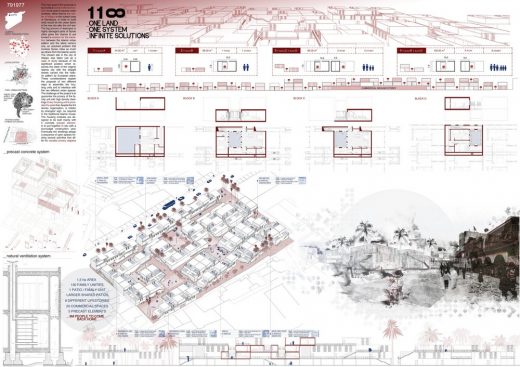
The vital part of the new housing concept should become a creation of such living conditions which will be attractive for once displaced Syrians to return. People, who spent years in temporary shelters and adapted buildings, will look for “solid ground” to begin a new life. New housing concept should be able to permanently accommodate people in need of a new home and become a new page in the history of Syria.
matterbetter has received 245 submissions. International Jury Board, which consisted from Urko Sanchez, Dick van Gameren, Felix Madrazo, Riccardo Luca Conti, Laurens Bekemans, Rune Asholt, Cristina Cassandra Murphy and Daria Polozkova, has selected the Winners and Honorable Mentions of the Syria: Post-War Housing Competition.
Winner 1st Place – Endless Future Project – 3000 EUR
Marta Gayoso, Alfredo De Luca, Elena Guidetti, Giulia Gorgo / Spain and Italy
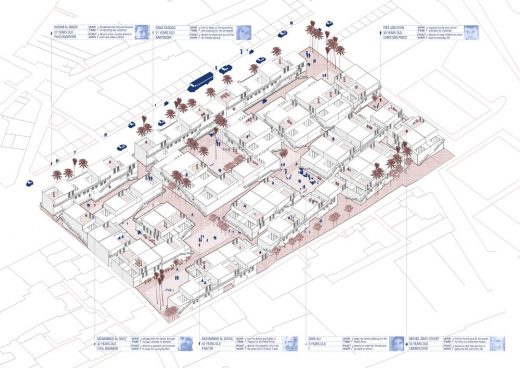
Winner 1st Place – Endless Future Project
791977 / Marta Gayoso, Alfredo De Luca, Elena Guidetti, Giulia Gorgo / Spain and Italy
Jury Comment:
Deep and vindictive reflexion claiming the transition architecture between the ancient islamic urban pattern and the latest century one. The proposal is a flexible system and the resulting urban pattern works though the housing typology could be revised. – Urko Sánchez
In depth research on the chosen case study. Flexibility reached with balanced modules. Study of construction materials and natural ventilation. Interesting idea to Introduce particular user’s needs. Not graphic as its best. Complete Project. – Riccardo Luca Conti
A project which is admirable for its in depth analyze of the local housing typologies, which are then re-designed for a modern life and today’s constructional regulations. The study on efficient building site organization is very relevant and interesting for the context the project is situated in.
I think this is very wise starting point for the project. The design as well proves to be a logic outcome of this study. The project takes a clear stand in not reusing the debris and focuses on a prefab construction system. A system which is refined in the design by combining it with a solar chimney in order to enhance the inner climate without any complex ventilation systems. An interesting marriage of ancestral techniques and conventional industrial materials. – Laurens Bekemans
Description from the team:
Endless Future project represents the will of coming back to a peaceful life and of repossessing of a territory. Future because it’s yet to come and yet to be built, Endless because its flexibility allows rearing it in different aspects, shapes and dimensions. The project is thought to re-create the destroyed residential urban pattern, foreshadowing the people in the post-war Syria would go back living the cities, just where they used at the dawn of the revolution, in the same streets that guard their most precious memories.
The dwellings are able to fit different financial abilities, in order to allow low-income families to live close to the center and guarantee cohabitation between high-class and poor class, as it was in the old Islamic city. In the same way they offer shelter to untraditional family units, which may consist of a single person who lost family, or of people who lost their loved ones and form a new family group, or big families with 3/4 children as is very often in Syria.
The case study chosen is the city of Aleppo, the biggest city in Syria and one of the most precious cities in the Islamic world due to its historical sites which have been hardly damaged in these years of civil war. Aleppo is the exemplum of the urban development occurred in many Islamic cities during the XXth century when straight road axes were imposed on the organic historical fabric which was partly destroyed.
These two warring urban form are different in terms of scale, form, accessibility and activities creating threatening tensions in the everyday running of the city. The re-built city design, therefore, can’t miss the chance of finding a solution to the transitions between the two dimensions of living.
The testing site stands in the area that was rounded by the ancient walls and delimited at the south by the straight boulevard of Al Mutannabi St. that interrupts the old organic pattern. The project foresees a first configuration of the house units put together in 2/3 stories blocks facing the old city, and a second one with 4 stories and a ground commercial level facing the main street.
The house unit is the result of different combinations of 4 living modules, providing different dimensions according to the various family units. The leading principle is to provide every house with a patio that becomes not only the open space where take place family activities, but also the core all the house develops around, dividing different functions according to Islamic family routine. The design assures privacy to the patio even with a multiple storey disposition and can be resumed as the combination of an entrance filter space that separate the living area that is also the male part, and the sleeping area that is the female one.
All the types of dwellings can be built with 5 differently dimensioned concrete precast elements, 3 wall panels, 1 floor slab and 1 stair slab. The precast construction system fits with the economic and industrial difficulties of a post-war country and is available to small worker teams and low-budget construction yards. The housing blocks use a common installations well that host a vertical wind catcher tower creating a natural ventilation and cooling mechanism in every house.
Endless Future project is thought to give a solid environment where Syrians return to feel being home and close to their traditions, where to share memories and write what sooner or later finally will be history, in order to face the hard challenges Syria will have to overcome.
Winner 2nd Place – Spring From Debris – 2000 EUR
Laura Serrano Romero, Marina Sánchez Guzmán, Martti Antonio Oliva Koskela, Emin Bekmezci / Spain and Turkey
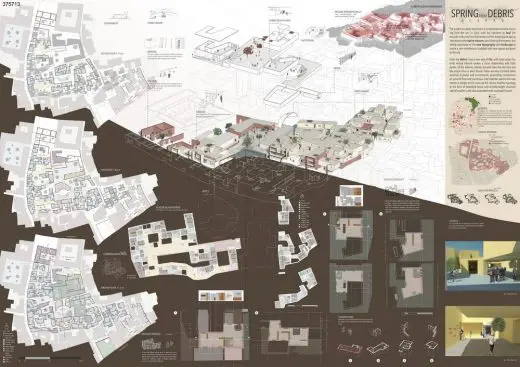
Winner 2nd Place – Spring From Debris
375713 / Laura Serrano Romero, Marina Sánchez Guzmán,
Martti Antonio Oliva Koskela, Emin Bekmezci / Spain and Turkey
Jury Comment:
Beautiful project.
It offers solutions from a very detailed analysis of a real area of the city. Thus, the proposal chooses to rebuild carefully, without losing the values of the different layers of the existing plot and transforming the voids caused by war into new opportunities for common spaces. The result is very interesting, it creates friendly urban spaces, as well as some attractive housing typologies. – Urko Sánchez
One of the few projects reaching a high level of urban reading. The image is capturing and shows the very thorough and detailed study of an existing urban situation and responds to this complex Syrian urban fabric with a honest architectural proposal. The design blends in the urban tissue and proposes modest adjustments which stands in relation to what is and is not destroyed. A project worth mentioning for its sensibilty and unpretentiousness. – Laurens Bekemans
Description from the team:
The project has been faced from a complicated scenario resulting from the war in Syria, with the intention to heal the wounds in the city from the remains of the existing and taking into account the native tissue to avoid losing the essence, but taking advantage of the new topography and landscape to create a new architecture sculpted with new spaces assigned to the city.
From the debris rises a new way of life, with large urban hybrids whose interior creates a close relationship with both patios, of the volume (mostly rescued from the old city) and the inside ones in each house. There are also included other activities (cultural and commercial), promoting connections on ground floor and numerous intermediate spaces and new streets in height which cover up the citizen. Another typology in the form of detached house with double-height structure sets of smaller scale also associated with courtyard houses.
The location was strategically selected. The main idea was to fix the cities from the inside to the outside, dealing with the most damaged blocks first, and the analysis of this turned out to be related with the position of the main mosques. That is why the project has its context in the Old City of Aleppo and pretends to be a new architecture adaptable to all Syria.
The debris concept – The healing includes the acceptance of the events of the war as part of the city history, that is the idea of keeping advantage of this material to configure the public space, as a terrain containment.
Some of the main public spaces are:
The Souk – Associated to the mosque it is located in the inside of the existing walls that provide a public path around the ancient building connected to commerce.
The Debris Square – It is the biggest free area of the project, in which it is respected the real height resulting of the debris in the current state, associated to public use, commerces and cafes, it connects the market and surroundings of the mosque with the Auditorium in the south of the block’s heart.
Auditorium – From the topography of a bomb in the war come of the idea of a dome sculpture in the main cultural building that solve the connection of different heights and provide at the same time a temporary scenario to the city center and a public open space.
The Street Market – Following the structure of the main souk rising from the remains walls this ancient dwelling helps as a smaller temporary local market.
The housing
Typology I – In each big hybrid volume there are dwellings in one storey. The strategy is repeated, the entrance is indirect due to privacy, the kitchen and living space with higher ceilings are related to a patio or skylight and the bedrooms are organized by cupboards.
Tyology II – The double-height single houses have some similarities with type I, because of the different heights of ceiling, that helps to define spaces and solve installations. The stairs associated to entrance and connect the downstairs service area (day life) with the upstairs served one (night life).
Construction – New walls would complement the ruins already existing. The stairs and the cupboards would be the flexible elements.
The main materials are concrete as a dwelling structure, wood for public lattices associated to light and public transit); debris and corten steel for containing walls and underground connection.
Winner 3rd Place – Back Home. Shards of Memories – 1000 EUR
Valerio Croci, Vincenzo Demasi, Fabrizio Esposito, Roberta D’Agrosa, Costanza Galli / Italy
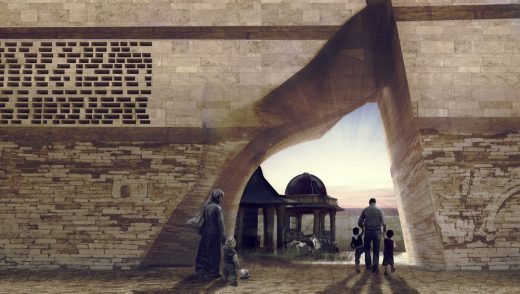
Winner 3rd Place – Back Home. Shards of Memories
222904 / Valerio Croci, Vincenzo Demasi, Fabrizio Esposito, Roberta D’Agrosa, Costanza Galli / Italy
Jury Comment:
Recycling, rebuilding, rehousing is a project with a very clear concept. It is not the first time we see this concept about reusing all the rubble that lies in the street to create new houses. However, making space for new hoses at the same time as you build it is still a very important issue and this project takes it very seriously.
The diagrams are conversing and together with the illustrations, it tells a story about using part of the old, to create a completely new place. In addition, doing this together gives it a new identity, not only as a building, but also between the people that came together to raise it. – Rune Asholt
This proposal is to mentioned for its visual impact and the story it wants to communicate. The intention of remembering and adapting is appreciated. Likewise, it is to be enjoyed the typology of patio houses where private and public spaces interact but do not overlap.
The phasing of this idea is interesting as it provides a positive programmatic flexibility. Perhaps reading between the lines, there is a intuitive tendency of creating a fortress around lives: considering the brutality of this experience, it almost seems like the designer decides to erect walls around people’s life as to protect them from damage. – Cristina Murphy
Description from the team:
Our proposal works with the idea to retrace shape of urban’s lot that were destroyed from war, in order to conserve the morphology and city’s identity. New buildings are assembled parlty with ruins, partly with new materials and they play the role of traditional syrian house organized around a courtyard. The idea is to realize two different type of courts: the shape of the urban lot is sorrounded with small and private courts, this system composes a single larger public courtyard which can accommodate different functions such as public or historical buildings, public gardens, mosques or attraction poles.
A wider urban network connects all these public spaces resulting in a new city’s identity and idea. Every building has a ground floor with commercial and public spaces in order to have a direct relationship with the courtyard; housing is developed on the higher floors. Single residential units are flexible houses with 25 mq of immediate living rooms and 20 to 50 mq of potential a dynamical space, that allows the owner to change the unit configuration in relation with his needs.
n the beginning every smaller couryard block will have services like kitchen, dining room and living spaces in common. With the passing of time these spaces will accommodate new different public functions or will become new houses for other families . The purpose is to establish a wide community to help each others to rebuild a new urban block, a new city and at last a new Sirya.
Honorable Mention – House100
107808 / Nemanja Mitrović, Đina Prnjat / Montenegro
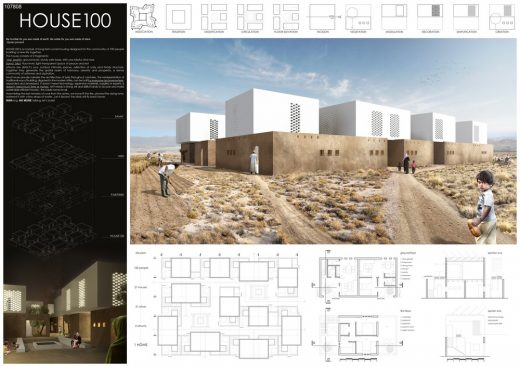
Honorable Mention – Cultivated Legacy
270672 / Hugo Lebrunet, Clément Loyer, Ulysse Zehnlé / France
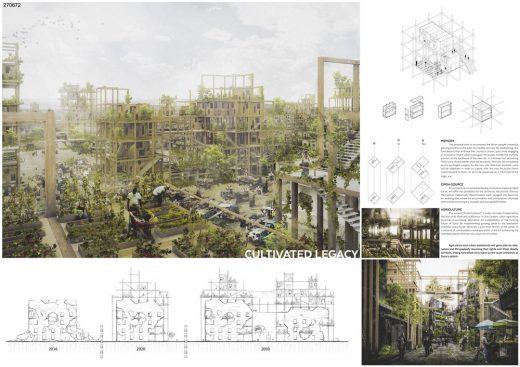
Honorable Mention – Extended Citadel
322825 / Giacomo Caputo / Italy
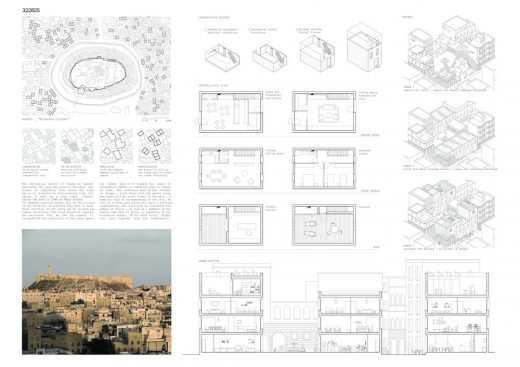
Honorable Mention – Top-Down Regeneration
482429 / Aleksandar Stanicic, Andrea Jelic / Italy
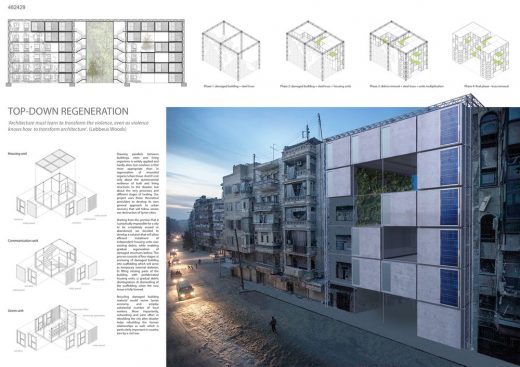
Honorable Mention – Phoenix
498464 / Petar Tomas, Tijana Perović, Jelica Babić / Montenegro
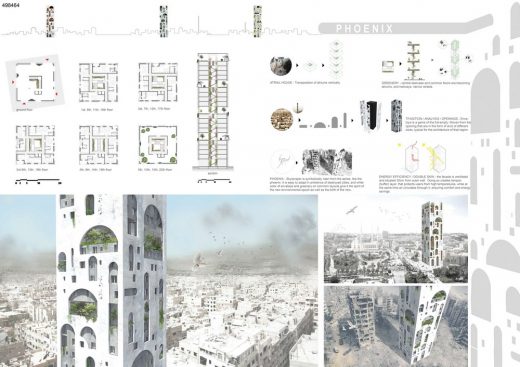
Honorable Mention – Typical Block / Lemon
548242 / Gordana Vujovic , Elzana Husovic, Nina Culafic / Montenegro
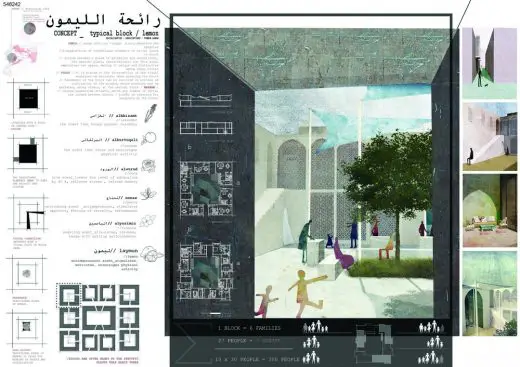
Honorable Mention – El Pati
631440 / Lukas Fertig, Matthias Knab / Spain and Germany
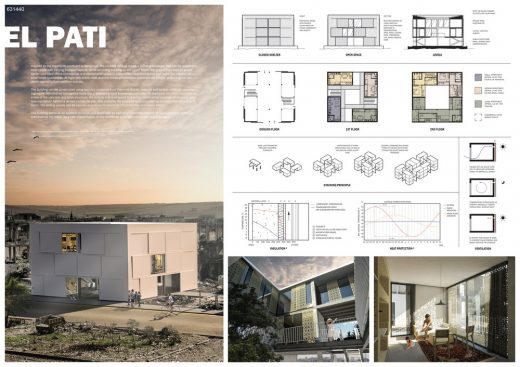
Honorable Mention – Therapeutic Decay
762865 / Hancheng Chen, Hsing-O Chiang / Taiwan
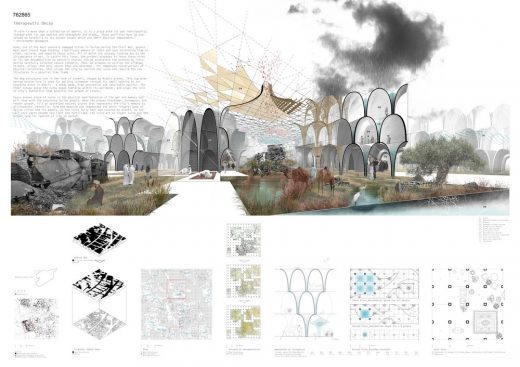
Honorable Mention – Gabion Block
770355 / Aleksandr Kelkh, Dmitrii Kupressov, Tatiana Kan, Vladimir Sorokin / Russia
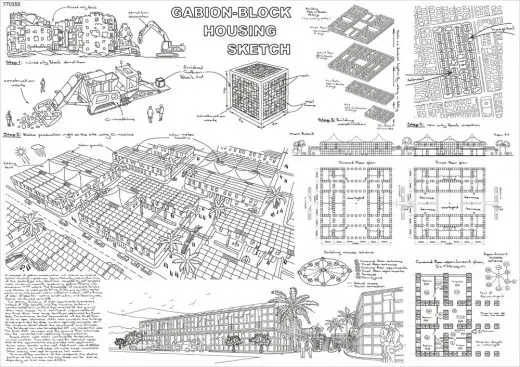
Syria: Post-War Housing Competition images / information received 190716
1 Feb 2016
Syria: Post-War Housing Competition News
Syria: Post-War Housing Competition 2016
matterbetter has initiated an international open ideas competition for architecture students and young architects to research new housing concepts for the future of the post-war Syria. The civil war in Syrian Arab Republic, which started in 2011, created the biggest refugee crisis after the World War II.
According to UNHCR, over 4,300,000 people has left the country and fled to Turkey, Lebanon, Jordan, Iraq and now Europe. While world leaders are looking for the international solution of the Syrian civil war and refugee crisis, many Syrians are looking forward for the opportunity to come back home as soon as the war is over.
Competition participants are asked to propose a solution for housing scarcity crisis, which will affect the country as more and more cities of the war-torn country will be freed and refugees will start to come back. Living conditions in the current refugee camps and temporary buildings across Europe and other countries are mostly inhuman, making refugees feel desperate, since there’s also nowhere to come back as the Syrian towns are in ruins, offering nothing to people who once lived there.
Participants were asked to
– Introduce new housing concept for the post-war Syria, which will in short-term provide qualitative solution for mass social housing with at least 50+ years lifespan;
– Choose either developed or non-developed site;
– Define approach towards existing constructions (damaged and/or ruined);
– Provide flexibility and adaptability of living spaces/buildings through time;
– Take into consideration local construction and living culture;
– Minimize energy consumption by implementing innovations in the field of sustainable design;
More information can be found in the Competition Brief.
Evaluation Criteria:
– Architectural innovation: aesthetics and originality;
– Integration of the new housing with chosen context;
– Flexibility of the housing layouts;
– Adaptability for various target groups;
– Reinterpretation of the local building culture;
– Sustainability, functionality, structural efficiency;
– Meeting the mission statement requirements;
– Meeting the submission requirements;
– Design representation clearness;
– Clarity and comprehensibility of the overall design.
Jury:
Urko Sanchez (ES/KE) – Founder Urko Sanchez Architects
Felix Madrazo (NL) – Co-Founder Inter.National.Design
Riccardo Luca Conti (UK) – Executive Director Catalytic Action
Laurens Bekemans (BE) – Founder BC Architects
Rune Asholt (DK) – Chairman Architects Without Borders (Arkitekter Uden Grænser)
Cristina Cassandra Murphy (US) – Owner XCOOP, former OMA
Daria Polozkova (NL/RU), Founder The ART GLOBE and art-director of Mir-Expo
www.matterbetter.com – architectural and design competitions / research platform
Syria: Post-War Housing Competition
Location: Syria, Middle East
Syrian Architecture
Lycée Français Charles de Gaulle, Damascus, Syria

pictures © AKAA / Alhadi Albaridi
Lycée Français Charles de Gaulle
Buildings in countries adjacent to Syria
Buildings / photos for the Syria: Post-War Housing Competition Winners News page welcome

